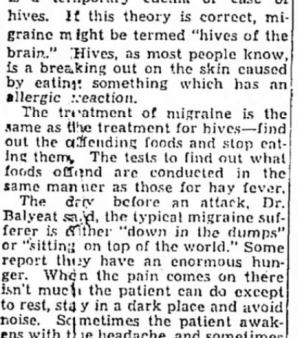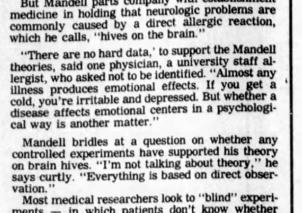Migraine: Is it really “Brain Hives”?
Strangely enough, the term “brain hives” has a history to it, when it comes to migraine. And I just heard the term again this year.

But Dr. Balyeat’s specialty was actually allergies. In fact, he had a successful clinic for patients with allergy and asthma.
So what did he see? Of course he began to notice similarities between migraine and allergic reactions. He saw incredible improvement in patients who simply avoided certain food triggers.
Now it’s easy to jump to the conclusion that just because a food triggers migraine attacks, that you’re “allergic”. It doesn’t seem to be that simple.
However, researchers continue to notice the connection between allergies and migraine.
We do know that, for example, migraine patients who are tested for common allergies seem to improve when they eliminate the offending foods from their diet (see Migraine and Food Allergy? New Study…). Food intolerance or “delayed” allergies are also an interesting field of research. These are problems that would not show up in a typical allergy test.
Migraine is indeed connected in some way to hay fever. People suffering from rhinitis, allergic and otherwise, do tend to have more problems with migraine (see What Most People Don’t Know About Migraine and Allergies (Hay Fever)).
The connection between migraine and histamine also provides another possible clue.

Dr. Marshall Mandell believed that most migraine attacks were in fact caused by “cerebral allergies”, such as chemical hypersensitivities (hypersensitivity – certainly a popular word in migraine research today!).
Though some of Dr. Mandell’s ideas would be dismissed today as they were then, he did take patients seriously when other doctors wrote off their headaches as “all in your head”. He used vitamin B, still commonly used in migraine treatment. And he recognized many environmental triggers that research has continued to bring to light.
All of this takes us into a world that is much more complicated than obvious allergic reactions causing migraine. But there’s no doubt that there is some kind of a connection. Were these doctors from the past really on to something?
Later this week we’ll take a closer look at hives, and migraine, and see what connections we can find.
